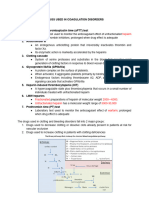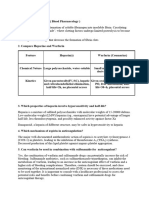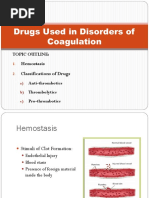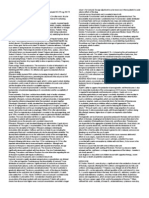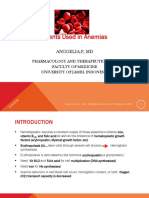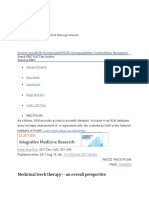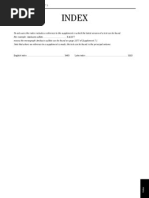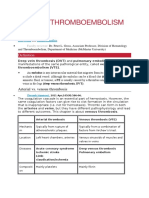0 ratings0% found this document useful (0 votes)
49 viewsAgent Used in Disorder in Coagulation
Agent Used in Disorder in Coagulation
Uploaded by
Clinton Franda Markus Sitanggang t-PA (alteplase, reteplase, tenecteplase)
t-PA is a serine protease that catalyzes the conversion of plasminogen to plasmin.
t-PA is used for acute myocardial infarction, ischemic stroke, and pulmonary embolism.
Advantages over streptokinase include greater specificity for fibrin and less risk of bleeding.
Reteplase and tenecteplase are genetically engineered variants of t-PA with longer half-lives allowing for bolus dosing.
Monitoring is not usually required but patients should be observed for bleeding
Copyright:
© All Rights Reserved
Available Formats
Download as PPTX, PDF, TXT or read online from Scribd
Agent Used in Disorder in Coagulation
Agent Used in Disorder in Coagulation
Uploaded by
Clinton Franda Markus Sitanggang0 ratings0% found this document useful (0 votes)
49 views34 pages t-PA (alteplase, reteplase, tenecteplase)
t-PA is a serine protease that catalyzes the conversion of plasminogen to plasmin.
t-PA is used for acute myocardial infarction, ischemic stroke, and pulmonary embolism.
Advantages over streptokinase include greater specificity for fibrin and less risk of bleeding.
Reteplase and tenecteplase are genetically engineered variants of t-PA with longer half-lives allowing for bolus dosing.
Monitoring is not usually required but patients should be observed for bleeding
Original Title
agent used in disorder in coagulation.pptx
Copyright
© © All Rights Reserved
Available Formats
PPTX, PDF, TXT or read online from Scribd
Share this document
Did you find this document useful?
Is this content inappropriate?
t-PA (alteplase, reteplase, tenecteplase)
t-PA is a serine protease that catalyzes the conversion of plasminogen to plasmin.
t-PA is used for acute myocardial infarction, ischemic stroke, and pulmonary embolism.
Advantages over streptokinase include greater specificity for fibrin and less risk of bleeding.
Reteplase and tenecteplase are genetically engineered variants of t-PA with longer half-lives allowing for bolus dosing.
Monitoring is not usually required but patients should be observed for bleeding
Copyright:
© All Rights Reserved
Available Formats
Download as PPTX, PDF, TXT or read online from Scribd
Download as pptx, pdf, or txt
0 ratings0% found this document useful (0 votes)
49 views34 pagesAgent Used in Disorder in Coagulation
Agent Used in Disorder in Coagulation
Uploaded by
Clinton Franda Markus Sitanggang t-PA (alteplase, reteplase, tenecteplase)
t-PA is a serine protease that catalyzes the conversion of plasminogen to plasmin.
t-PA is used for acute myocardial infarction, ischemic stroke, and pulmonary embolism.
Advantages over streptokinase include greater specificity for fibrin and less risk of bleeding.
Reteplase and tenecteplase are genetically engineered variants of t-PA with longer half-lives allowing for bolus dosing.
Monitoring is not usually required but patients should be observed for bleeding
Copyright:
© All Rights Reserved
Available Formats
Download as PPTX, PDF, TXT or read online from Scribd
Download as pptx, pdf, or txt
You are on page 1of 34
Drug Used in Disorder of Coagulation
(Including drug used to limit abnormal bleeding and to inhibit
thrombosis)
ANGGELIA P, MD
PHARMACOLOGY AND THERAPEUTIC DEPT.
FACULTY OF MEDICINE
UNIVERSITY OF JAMBI, INDONESIA
ANGGELIA P, MD. PHARMACOLOGY AND THERAPEUTIC DEPT. 1
NORMAL HEMOSTATIC MECHANISM
Hemostasis refers to the finely regulated dynamic
process of maintaining fluidity of the blood,
repairing vascular injury, and limiting blood loss
while avoiding vessel occlusion (thrombosis) and
inadequate perfusion of vital organs.
There are four phases to the
normal coagulation cascade:
Blood vessel constriction
Platelet aggregation
Fibrin generation
Vessel repair and fibrin
degradation
ANGGELIA P, MD. PHARMACOLOGY AND THERAPEUTIC DEPT. 2
MECHANISM OF BLOOD COAGULATION
ANGGELIA P, MD. PHARMACOLOGY AND THERAPEUTIC DEPT. 3
PLATELET PLUG
ANGGELIA P, MD. PHARMACOLOGY AND THERAPEUTIC DEPT. 4
COAGULATION CASCADE
ANGGELIA P, MD. PHARMACOLOGY AND THERAPEUTIC DEPT. 5
COAGULATION CASCADE
ANGGELIA P, MD. PHARMACOLOGY AND THERAPEUTIC DEPT. 6
INHIBITION OF COAGULATION
ANGGELIA P, MD. PHARMACOLOGY AND THERAPEUTIC DEPT. 7
INTRODUCTION
Human body controlling coagulation process by activated plasmin, antithrombine
synthesized and activating protein C and S.
Antitrombotic:
I. anticoagulation
• Indirect thrombin inhibitor (heparin : UFH, LMWH, synthetic heparin
derivates…fondaparinux)
• Direct trombin inhibitor (hirudin_lepirudine, bivalirudin, argatroban, melagatran)
• Vit K antagonist (warfarin and coumarin derivates)
• Direct Xa inhibitor (rivaroxaban)
II. Fibrinolytic drug (streptokinase, urokinase, t-Pas_alteplase, reteplase, teneplase)
III. Antiplatelet drug (aspirin, clopidrogel, abciximab, dypiridamol+aspirin, cilostazol)
ANGGELIA P, MD. PHARMACOLOGY AND THERAPEUTIC DEPT. 8
ANTICOAGULANT
ANGGELIA P, MD. PHARMACOLOGY AND THERAPEUTIC DEPT. 9
ANTICOAGULANT DRUGS
Vitamin K Direct thrombin
Heparins antagonists inhibitors
Unfractionated Warfarin Hirudin
heparin (UFH)
Coumarin Recombinant
Low molecular - Lepirudin
weight heparin - Bivalirudin
(LMWH)
Synthetic
Synthetic - Argatroban
pentasaccharides
- Melagatran
(fondaparinux,
- Dabigatran
idraparinux)
-
ANTICOAGULANT
I. INDIRECT TROMBIN INHIBITOR
ANGGELIA P, MD. PHARMACOLOGY AND THERAPEUTIC DEPT. 12
INDIRECT THROMBIN INHIBITOR (HEPARIN)
Heparin is a heterogeneous mixture of sulfated
mucopolysaccharides
Mechanism of action
Biologic activity is dependent upon the endogenous
anticoagulant antithrombin.
Cofactor that accelerated by 1000-fold antithrombin inhibits
clotting factor proteases, especially thrombin (IIa), IXa, and Xa,
by forming equimolar stable complexes with them.
Heparin extract from porcine intestinal mucosa or bovine lung
Antidotum: protamine sulfate
ANGGELIA P, MD. PHARMACOLOGY AND THERAPEUTIC DEPT. 13
INDIRECT THROMBIN INHIBITOR (HEPARIN)
Consist of:
Unfractionated heparin (height weight moleculer heparin)_UFH
Low weight moleculer heparin (enoxaparin, dalteparin, and
tinzaparin) _LMH
Synthesized derivated heparin (Fondaparinux ).
LMH inhibit activated factor X but have less effect on thrombin
than the HMW species
LMH have equal efficacy with UHF, increased bioavailability by
SC inj and less frequent doses.
ANGGELIA P, MD. PHARMACOLOGY AND THERAPEUTIC DEPT. 14
INDIRECT THROMBIN INHIBITOR (HEPARIN)
Routine monitoring aPTT need for used of UHF, just adjusment
needed. Maintain prolongation of the aPTT to 2–2.5 times
Coagulation monitoring for LMH used is not done routinely, LMH
giving once/twice/day with fixed dose or /kgbb
Fondaparinux can be given once a day at a fixed dose without
coagulation monitoring.
Precaution for renal failure patient.
ANGGELIA P, MD. PHARMACOLOGY AND THERAPEUTIC DEPT. 15
INDIRECT THROMBIN INHIBITOR (TOXICITY)
Bleeding (Increased risk in elder women and renal failure
Allergy reaction
Alopesia or increased loss of hair
Long term therapy: osteoporosis, spontaneous fracture and
deficiency of mineralocorticoid.
Heparin induced trombocitopenia, occurs in 1–4% of individuals
treated with UFH for a minimum of 7 days.
KI: patient with bleeding or risk of bleeding.
ANGGELIA P, MD. PHARMACOLOGY AND THERAPEUTIC DEPT. 16
ANTICOAGULANT
II. DIRECT TROMBIN INHIBITOR
ANGGELIA P, MD. PHARMACOLOGY AND THERAPEUTIC DEPT. 17
DIRECT THROMBIN INHIBITOR
Mechanism of action by directed binding to the active site of thrombin
Hirudin and bivalirudin are bivalent DTIs in that they bind at both the catalytic or
active site of thrombin as well as at a substrate recognition site.
Argatroban and melagatran are small molecules that bind only at the thrombin
active site.
Hirudin recombinant_lepirudin…. approved by the Food and Drug Administration
for use in patients with thrombosis related to heparin-induced thrombocytopenia.
Parenterally used
Lepirudin is excreted by the kidney and should be used with great caution in
patients with renal insufficiency as no antidote exists
Bivalirudin also inhibits platelet activation and has been FDA-approved for use in
percutaneous coronary angioplasty.
ANGGELIA P, MD. PHARMACOLOGY AND THERAPEUTIC DEPT. 18
DIRECT TROMBIN INHIBITOR
Argatroban
• FDA-approved for use in patients with HIT with or without thrombosis and coronary
angioplasty in patients with HIT.
• Has a short half-life, is given by continuous intravenous infusion, and is monitored by
aPTT.
• Its clearance is not affected by renal disease but is dependent on liver function.
Ximelagatran
• Oral prodrug that is metabolized to the DTI melagatran.
• Potential advantages of ximelagatran include predictable pharmacokinetics and
bioavailability.
• This allows for fixed dosing and predictable anticoagulant response; no need for routine
coagulation monitoring; lack of interaction with P450-interacting drugs; and rapid onset
and offset of action,
ANGGELIA P, MD. PHARMACOLOGY AND THERAPEUTIC DEPT. 19
DIRECT TROMBIN INHIBITOR
Dabigatran
• Direct competitive inhibition of trombin, inhibit free and clot bound trombin and
trombin induced platelet aggregation
• Not a substrate, inhibitor or inducer of CYP450 enzyme
• T1/2 12-17 h, oral dosing form, BID
• Urine excretion up to 80%
ANGGELIA P, MD. PHARMACOLOGY AND THERAPEUTIC DEPT. 20
ANTICOAGULANT
III. VITAMIN K ANTAGONIST
ANGGELIA P, MD. PHARMACOLOGY AND THERAPEUTIC DEPT. 21
VITAMIN K ANTAGONISTS – MECHANISM OF
ACTION
VITAMIN K ANTAGONISTS – MECHANISM OF
ACTION
ANGGELIA P, MD. PHARMACOLOGY AND THERAPEUTIC DEPT. 23
VITAMIN K-DEPENDENT CLOTTING FACTORS
Varying half-life (6-72 hours)
Anticoagulant effect of vitamin K antagonists starts after
several days
VIT K ANTAGONIST (WARFARIN)
• Warfarin is generally administered as the sodium salt and has 100%
bioavailability.
• Over 99% of racemic warfarin is bound to plasma albumin, which may contribute
to its small volume of distribution (the albumin space), its long half-life in plasma
(36 hours), and the lack of urinary excretion of unchanged drug.
• Warfarin crosses the placenta readily and can cause a hemorrhagic disorder in
the fetus.
• Treatment with warfarin should be initiated with standard doses of 5-10 mg
rather than the large loading doses formerly used.
ANGGELIA P, MD. PHARMACOLOGY AND THERAPEUTIC DEPT. 25
WARFARIN
Slow onset and offset of action. This takes about 3-4 days.
The initial treatment with VKAs, such as warfarin, must therefore
always be combined with heparin
When rapid reversal is required, fresh frozen plasma or coagulation
factor concentrates can be administered. Vitamin K can also be
administered but the effect of this treatment is delayed.
Numerous interactions with alcohol, foods containing vitamin K, with
foods and drugs metabolised by cytochrome P450 enzymes and with
foods and drugs which interfere with gastrointestinal absorption
Paper 1; pharmacodynamic and kinetic drug interaction of warfarin
RIVAROXABAN (NEW ORAL ANTICOAGULAN)
• Factor Xa inhibitor that inhibit platelet activation by selectively blocking the active
site of factor Xa without requiring cofactor (eg. Antitrombin) fir activity
• Bioavailability : 80-100% ; Protein 92-95%; metabolized by oxidative degradation
catalyzed by CYP3A4/5; T1/2 5-9 h; excreted in feces and urine.
• PO dosing form
ANGGELIA P, MD. PHARMACOLOGY AND THERAPEUTIC DEPT. 27
FIBRINOLYTIC DRUG
Lyse thrombin by catalyzing of plasmin
Consist of: Streptokinase, urokinase, t-Pas(alteplase, reteplase, tenecteplase)
Streptokinase enzym synthesized by streptococci that combines with the
proactivator plasminogen.
Urokinase is a human enzyme synthesized by the kidney that directly converts
plasminogen to active plasmin.
Plasminogen can also be activated endogenously by tissue plasminogen
activators (t-PAs). Human t-PA is manufactured as alteplase by means of
recombinant DNA technology.
Indication : pulmonary embolism with hemodynamic instability, severe deep
venous thrombosis such as the superior vena caval syndrome, and ascending
thrombophlebitis of the iliofemoral vein with severe lower extremity edema.
Golden period, 6 hours after symptom onset of MCI
ANGGELIA P, MD. PHARMACOLOGY AND THERAPEUTIC DEPT. 28
ANTIPLATELET DRUG
1. Inhibition of PGI2 (TXA2)….prevent paltelet aggregation…aspirin
2. Inhibition of ADP…no effect of PGI2 (TXA2)….clopidrogel
3. Blockage of platelet glycoprotein II A/III A receptor…abciximab, tirofiban, and
eptifibatide
4. Additional antiplatelet…dypiridamol, cilostazol (phospodiesterase inhibitor ,
promote vasodilatation)
Paper II: Pharmacology antiplatelet drug !!!!
ANGGELIA P, MD. PHARMACOLOGY AND THERAPEUTIC DEPT. 29
SYSTEMIC HEMOSTATIC
ANGGELIA P, MD. PHARMACOLOGY AND THERAPEUTIC DEPT. 30
PLASMA FRACTION
Cryoprecipitate
FFP
Prothrombin complex concentrates (intermediate purity factor IX concentrates)
Recombinant factor VIII products
Recombinant factor IX products
PAPER 3 clinical used?
+ desmopresisn asetat…synthetic vasopresin…increased Fc VIII and vWf…
ANGGELIA P, MD. PHARMACOLOGY AND THERAPEUTIC DEPT. 31
VIT K
Vit K related cascade factor IIa, VII, IX, and X
K1: leafy green vegetables…..orally and parenteral
Onset 6 h…completely action 24 hours, newborn routine
administration to prevent hemorrage.
K2: synt by bacteria in human intestine
ANGGELIA P, MD. PHARMACOLOGY AND THERAPEUTIC DEPT. 32
FIBRINOLITIC INHIBITOR
Aminocaproic acid (EACA)….competitively Inhibit plasminogen
activation
Rapidly orally absorbed and excretion via urine.
Adverse effect: skin rash, hipotensi, nose stifness… be aware of
general trombosis
Tranexamid acid (analog aminocaproic acid)…10x more potent
and less side effect. Available in indonesia
Rapidly absorbed, dose 0,5-1 g…2-3x/daily…slowly IV injc…
Th/ for bleeding ec fibrinolitic therapy….avoid used for DIC
ANGGELIA P, MD. PHARMACOLOGY AND THERAPEUTIC DEPT. 33
TERIMAKASIH
ANGGELIA P, MD. PHARMACOLOGY AND THERAPEUTIC DEPT. 34
You might also like
- Hema Prelim MergedDocument112 pagesHema Prelim MergedRich Darlene Dela CruzNo ratings yet
- JJ Notes PhysiologyDocument192 pagesJJ Notes PhysiologyTanish Patil roll no 50100% (5)
- AnticoagulantDocument34 pagesAnticoagulantAslam Baltee100% (1)
- Agent Used in Disorder in CoagulationDocument41 pagesAgent Used in Disorder in CoagulationArtika MayandaNo ratings yet
- Anti CoagulantsDocument37 pagesAnti CoagulantsMaria khurshidNo ratings yet
- Drugs Used in Coagulation DisordersDocument40 pagesDrugs Used in Coagulation DisordersAmnaNo ratings yet
- Drugs Used in Coagulation DisordersDocument9 pagesDrugs Used in Coagulation DisorderschichandesuNo ratings yet
- ReviewerDocument20 pagesReviewerKC PalattaoNo ratings yet
- Presentation. 111tom AbDocument20 pagesPresentation. 111tom AbTemesgenNo ratings yet
- Anticoagulants 161120143945Document29 pagesAnticoagulants 161120143945Roshan SahuNo ratings yet
- Drugs Used in Coagulation Disorders and Agents Used in DyslipidemiaDocument20 pagesDrugs Used in Coagulation Disorders and Agents Used in Dyslipidemiamjd13mjd4No ratings yet
- Anticoagulants May BeDocument5 pagesAnticoagulants May BeAmmar magdyNo ratings yet
- ANTI COUGULANTS.ppt1Document18 pagesANTI COUGULANTS.ppt1sa0346799No ratings yet
- Anticoagulantes ParenteralesDocument19 pagesAnticoagulantes ParenteralesCamilo PérezNo ratings yet
- Agents Used in Coagulation Disorders: Dr. Bayu Lestari, M. Biomed Dr. Elly Mayangsari, M. BiomedDocument47 pagesAgents Used in Coagulation Disorders: Dr. Bayu Lestari, M. Biomed Dr. Elly Mayangsari, M. BiomedNia UswantiNo ratings yet
- Receiving Concurrent Moderate CYP3A4 Inhibitors (Erythromycin, Saquinavir, Verapamil, Fluconazole) - 25 MG Once Daily InitiallyDocument272 pagesReceiving Concurrent Moderate CYP3A4 Inhibitors (Erythromycin, Saquinavir, Verapamil, Fluconazole) - 25 MG Once Daily InitiallyFatima Doran PandaogNo ratings yet
- Drugs Used in Disorders of CoagulationDocument60 pagesDrugs Used in Disorders of CoagulationTwinkle MazaredoNo ratings yet
- Cardiovascular Drugs (coagulation)Document39 pagesCardiovascular Drugs (coagulation)niaradya.anya.2310116No ratings yet
- Blood 2Document3 pagesBlood 2merosasa238No ratings yet
- AnticoagulantsDocument44 pagesAnticoagulantsdrjscsanjay2225No ratings yet
- Anti CoagulantsDocument49 pagesAnti Coagulantsdeepikabansal965No ratings yet
- Pharmacology of Anticoagulants: Chandravathi Loke, MD, Syed S. Ali, MD, and Vandita Johari, MDDocument7 pagesPharmacology of Anticoagulants: Chandravathi Loke, MD, Syed S. Ali, MD, and Vandita Johari, MDluqmanhasansNo ratings yet
- Lecture 20-1 Drug That Modify Blood Coagulation (Pharmacology)Document27 pagesLecture 20-1 Drug That Modify Blood Coagulation (Pharmacology)7vgp7dhbrkNo ratings yet
- Heparin - ClinicalKeyDocument85 pagesHeparin - ClinicalKeydayannaNo ratings yet
- AnticoagulatsDocument52 pagesAnticoagulatsanaya khan StudentNo ratings yet
- Anticoagulant TherapyDocument41 pagesAnticoagulant Therapyryan yovan100% (1)
- Anti Coagulants & FibrinolyticsDocument54 pagesAnti Coagulants & FibrinolyticsSunanda mohanNo ratings yet
- Mid Human Pharma 23-24Document6 pagesMid Human Pharma 23-24Linh NguyễnNo ratings yet
- Anti Coagulants, Antiplatelets ANDCDocument35 pagesAnti Coagulants, Antiplatelets ANDCjutttoxicNo ratings yet
- AntiarrhythmiaDocument29 pagesAntiarrhythmiaDRx Raju ChandranNo ratings yet
- 12 MalariaDocument61 pages12 MalariaMewael TesfamichaelNo ratings yet
- Anticoagulants: Presented By: ABHILASH Moderator: DR CH RAHUL MDDocument103 pagesAnticoagulants: Presented By: ABHILASH Moderator: DR CH RAHUL MDabhilashreddy45100% (1)
- Drug Therapy For Blood Disorders. NURS2135Document35 pagesDrug Therapy For Blood Disorders. NURS2135s140138No ratings yet
- Heparin ResistanceDocument6 pagesHeparin ResistanceAditya MahajanNo ratings yet
- Drug StudyDocument5 pagesDrug StudyJoyce Anne SupnetNo ratings yet
- Drugs Used in Disorders of CoagulationDocument61 pagesDrugs Used in Disorders of CoagulationDUEÑAS, MARIELNo ratings yet
- AnticoagulationDocument12 pagesAnticoagulationMohamed BahhaNo ratings yet
- Anticoagulant PresentationDocument29 pagesAnticoagulant Presentationrozha100% (3)
- 3 - Blood MedicationDocument16 pages3 - Blood Medicationcrstian spatariNo ratings yet
- Acetyl Salsilic Acid محاضرة 8 علم أدويةDocument5 pagesAcetyl Salsilic Acid محاضرة 8 علم أدويةmohammedshw737No ratings yet
- Banua, Latigar, Rona - PCOL 2 - ReviewerDocument61 pagesBanua, Latigar, Rona - PCOL 2 - ReviewerDiane BanuaNo ratings yet
- Anticoagulant, Fibrinolytic, and Antiplatelet DrugsDocument22 pagesAnticoagulant, Fibrinolytic, and Antiplatelet DrugsVera Waty100% (1)
- AnticoagulantsDocument19 pagesAnticoagulantsOsama ZbedaNo ratings yet
- New Oral New Oral Anticoagulants G: RB H TT MD Rebecca Hanratty, MD Denver Health April 12, 2011Document55 pagesNew Oral New Oral Anticoagulants G: RB H TT MD Rebecca Hanratty, MD Denver Health April 12, 2011andresrgomezNo ratings yet
- Coagulants and AnticoagulantsDocument29 pagesCoagulants and AnticoagulantsfdamissieNo ratings yet
- Tishk International University: ApixabanDocument4 pagesTishk International University: ApixabanDyar MzafarNo ratings yet
- L8 Anti Coagulant DrugsDocument10 pagesL8 Anti Coagulant DrugsamanabduwahabNo ratings yet
- Vademecum MedicationsDocument19 pagesVademecum MedicationsScribdTranslationsNo ratings yet
- Anti Coagulant PRESDocument27 pagesAnti Coagulant PRESenocknyachi6No ratings yet
- New Drugs 2018 TableDocument5 pagesNew Drugs 2018 TableKirthikaRaghuramanNo ratings yet
- Pharmacology - Hematologic DrugsDocument51 pagesPharmacology - Hematologic DrugsBenjamin Joel Breboneria100% (1)
- Pharm 4.2Document39 pagesPharm 4.2Samdisha DebraNo ratings yet
- Newer Oral Anticoagulant: DR Shivaom Chaurasia Resident Internal MedicineDocument57 pagesNewer Oral Anticoagulant: DR Shivaom Chaurasia Resident Internal MedicineMuhammad Reza FirdausNo ratings yet
- Anticoagulantes ParenteralesDocument23 pagesAnticoagulantes ParenteralesNube AzulNo ratings yet
- Drugs Use in HemostasisDocument47 pagesDrugs Use in HemostasiskadibhaNo ratings yet
- New Drugs 2018: New Drug Mechanism of Action UseDocument7 pagesNew Drugs 2018: New Drug Mechanism of Action UsePremangshu GhoshalNo ratings yet
- Anticoagulation PharmacologyDocument36 pagesAnticoagulation PharmacologyaymenNo ratings yet
- Myrin P ForteDocument3 pagesMyrin P ForteJohn Zedric Villanueva ArciagaNo ratings yet
- AnticoagulantsDocument64 pagesAnticoagulantsnainapattnaikNo ratings yet
- Bivalirudine Drug Presentation From Nicvd DhakaDocument28 pagesBivalirudine Drug Presentation From Nicvd DhakaNavojit ChowdhuryNo ratings yet
- Top 100 Drugs Pocket Reference Guide (2023 Edition)From EverandTop 100 Drugs Pocket Reference Guide (2023 Edition)No ratings yet
- Critical Care Medications: Anti-Arrhythmics Study Guide: Critical Care EssentialsFrom EverandCritical Care Medications: Anti-Arrhythmics Study Guide: Critical Care EssentialsNo ratings yet
- Global Prevalence of Presbyopia and VisionDocument8 pagesGlobal Prevalence of Presbyopia and VisionClinton Franda Markus SitanggangNo ratings yet
- Delayed Homicides and The Proximate Cause: Peter Lin, MD, and James R. Gill, MDDocument4 pagesDelayed Homicides and The Proximate Cause: Peter Lin, MD, and James R. Gill, MDClinton Franda Markus SitanggangNo ratings yet
- Minimally Invasive Versus Abdominal Radical HysterectomyDocument10 pagesMinimally Invasive Versus Abdominal Radical HysterectomyClinton Franda Markus SitanggangNo ratings yet
- Maintenance Olaparib in Patients With Newly DiagnosedDocument11 pagesMaintenance Olaparib in Patients With Newly DiagnosedClinton Franda Markus SitanggangNo ratings yet
- Discogenic LBP Revised September 2017Document13 pagesDiscogenic LBP Revised September 2017Clinton Franda Markus SitanggangNo ratings yet
- Nervus Cranialis 257Document8 pagesNervus Cranialis 257Clinton Franda Markus SitanggangNo ratings yet
- Hasil Analisis Data SPSS Univariat: 1. PerokokDocument5 pagesHasil Analisis Data SPSS Univariat: 1. PerokokClinton Franda Markus SitanggangNo ratings yet
- Agent Used in AnemiasDocument30 pagesAgent Used in AnemiasClinton Franda Markus SitanggangNo ratings yet
- Physiology of BloodDocument73 pagesPhysiology of BloodAggamemnon populosNo ratings yet
- Biochem Hemostatis and ThrombosisDocument54 pagesBiochem Hemostatis and ThrombosischayChay gapolNo ratings yet
- Ain Shams University - Clinical Pathology Ain ShamsDocument182 pagesAin Shams University - Clinical Pathology Ain ShamsRowaa SamehNo ratings yet
- Routine Laboratory Evaluation of CoagulationDocument7 pagesRoutine Laboratory Evaluation of CoagulationGilo IlaganNo ratings yet
- BOU JAOUDEH Melissa These 2023Document250 pagesBOU JAOUDEH Melissa These 2023Sihem KbjNo ratings yet
- Cardiac Essentials Cardiovascular PharmacologyDocument210 pagesCardiac Essentials Cardiovascular PharmacologyelanthamizhmaranNo ratings yet
- Medicinal Leech TherapyDocument24 pagesMedicinal Leech TherapyKingNo ratings yet
- 7th Edition 7.1Document50 pages7th Edition 7.1eshwar_org100% (1)
- Resistance To InfectionDocument94 pagesResistance To Infectionvergel john ErciaNo ratings yet
- A New Understanding of The Coagulation ProcessDocument6 pagesA New Understanding of The Coagulation Processwuryan dewiNo ratings yet
- 10-Platelet Structure and Function PDFDocument21 pages10-Platelet Structure and Function PDFAnil Sharma100% (1)
- Overview of Hemostasis and ThrombosisDocument12 pagesOverview of Hemostasis and ThrombosisMichaella AlmirahNo ratings yet
- 2 Inherited Bleeding Disorders: Victor S. Blanchette Cathy Sparling Christopher TurnerDocument42 pages2 Inherited Bleeding Disorders: Victor S. Blanchette Cathy Sparling Christopher Turnershinichi kudoNo ratings yet
- Secondary HemostasisDocument8 pagesSecondary Hemostasisbsramos2023No ratings yet
- Coagulation of BloodDocument16 pagesCoagulation of BloodMoner ManushNo ratings yet
- PHYSIOLOGY SEM 1 SAQs and LAQs With AnswersDocument21 pagesPHYSIOLOGY SEM 1 SAQs and LAQs With Answerszipporahwaithera404No ratings yet
- Hemoststic AgentsDocument17 pagesHemoststic AgentsJoseph John K PothanikatNo ratings yet
- Labmed33 0948Document6 pagesLabmed33 0948VKTNNo ratings yet
- Components JLVDocument175 pagesComponents JLVHarry PatriceNo ratings yet
- Venous ThromboembolismDocument14 pagesVenous ThromboembolismCélia BetkaouiNo ratings yet
- Reptilase: Haemocoagulase 1 NIH UnitDocument21 pagesReptilase: Haemocoagulase 1 NIH UnitkyawkyawhtayNo ratings yet
- Week 11 - Hema Lec Major Anticoagulants SystemDocument7 pagesWeek 11 - Hema Lec Major Anticoagulants SystemCzarina Mae IlaganNo ratings yet
- Diajukan Untuk Melengkapi Persyaratan Mencapai Gelar Dokter Spesialis Penyakit DalamDocument70 pagesDiajukan Untuk Melengkapi Persyaratan Mencapai Gelar Dokter Spesialis Penyakit DalamMohammad SutamiNo ratings yet
- Human-Anatomy-Physiology-Chapter-5-Haemopoietic-System-NotesDocument9 pagesHuman-Anatomy-Physiology-Chapter-5-Haemopoietic-System-Notesmohammadwaseem4156No ratings yet
- Pharmacology of Drugs Used in StrokeDocument93 pagesPharmacology of Drugs Used in StrokemehakNo ratings yet
- 1-2 Hemostasis PhysiologyDocument48 pages1-2 Hemostasis PhysiologyHussein Al Saedi100% (2)
- Blood Clotting MechanismDocument19 pagesBlood Clotting Mechanismchinecheremstephanie2022No ratings yet
- A Brief History of HemophiliaDocument127 pagesA Brief History of HemophiliaApurba SahaNo ratings yet






